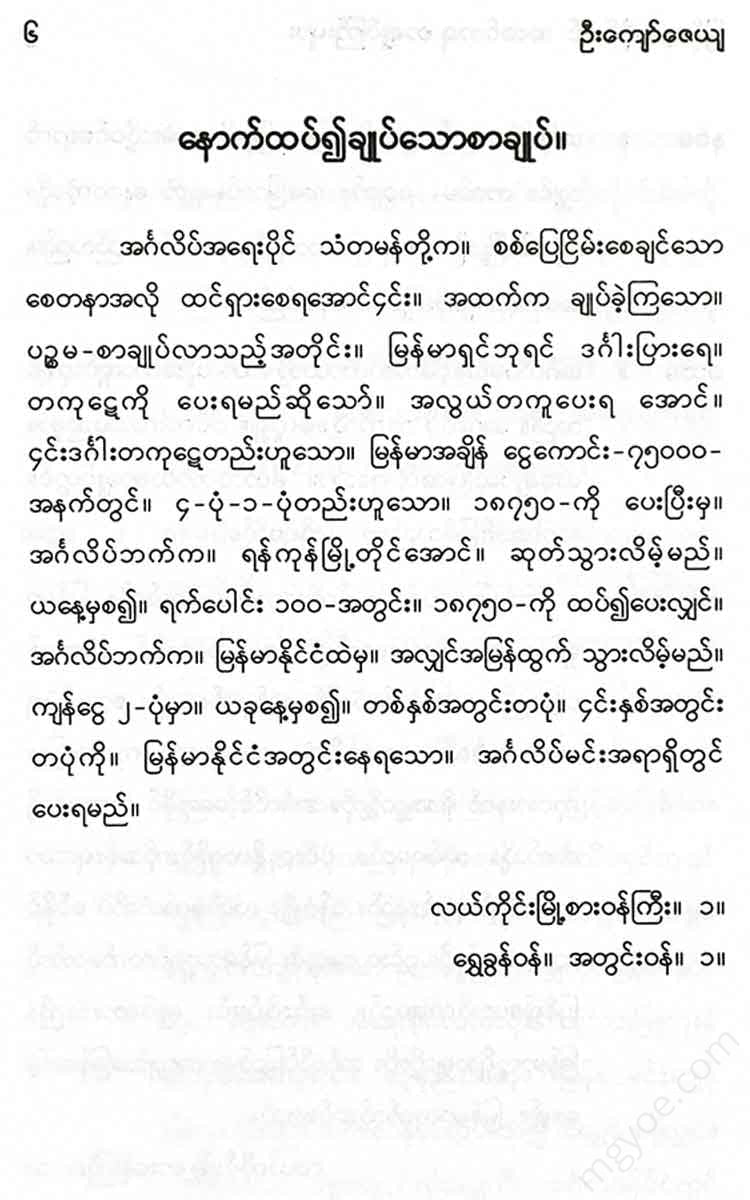Other Websites
U Kyaw Zeya - Important treaties in Myanmar's history
U Kyaw Zeya - Important treaties in Myanmar's history
Couldn't load pickup availability
On August 19, 1945, at the “Nathryn People’s Meeting,” General Aung San, Chairman of the Anti-Fascist People’s Freedom League (PB.F), Commander-in-Chief of the Patriotic Burma Army and the People’s Guerrilla Forces, delivered a speech. In that speech, he addressed the issue of the Patriotic Burma Army as follows:
“... Before concluding, I would like to mention the Tatmadaw issue. It is generally said that our Tatmadaw will be incorporated into the British government’s Burma Army in name only. There are many points that we have not clarified. Therefore, the League will present the demands regarding the Tatmadaw at this meeting in accordance with the points we want. If the country supports this, I believe that we Tatmadaw members can work together. However, I also want you to know that 99 out of 100 people in the Tatmadaw of an independent Burma would not like to serve if possible. Therefore, I would like to conclude by asking you to join the People’s Independence League and work towards the unity of the country so that the Tatmadaw can return to an independent country and gain independence peacefully.
In addition, the “Burma Army Motion” was submitted by Deedok U Ba Cho, and General Aung San re-read and explained the motion and submitted it again. The motion was supported by U Aye, former minister and leader of the Patriotic Party, and Mann Ba Khaing, a Karen nationalist leader.
The decisions made by the Nay Pyi Taw General Assembly were also overwhelmingly supported by large public meetings held in various townships of Burma. The various mass organizations and unions affiliated with the Anti-Fascist People's Freedom League also decided to strongly support the Nay Pyi Taw resolutions. When the British authorities realized how strong the political sentiments of the Burmese people were and how united the people were under the leadership of the Anti-Fascist People's Freedom League, the Allied Commander-in-Chief, Lord Mountbatten, invited the leaders of Burma to Kandy, Ceylon (now Sri Lanka), where the Allied Headquarters was located at that time, to discuss the issue of the Burmese Army.
In response to this invitation, the Anti-Fascist People's Freedom League sent a delegation to Kanni on September 4, 1945, consisting of the following individuals:
-
The delegation includes:
1. General Aung San
2. Bolekya (wild pigeon)
3. General Ne Win
4. U Ba Pe (Grandfather Ba Pe, deceased)
5. Thakin Than Tun (Communist leader, deceased)
6. Ko Nyo Tun (Former Ambassador)
7. Saw Ba U Gyi (KNDO leader, deceased)
8. General Zeya (Communist, deceased)
9. Lieutenant Colonel Kyaw Zaw (Taw Ko)
10. Bo Maung Maung (Former Ambassador)
11. General Zaw Min and others participated.
On September 6 and 7, 1945, after discussions between the Allied Supreme Commander-in-Chief, Lord Mountbatten, and a Burmese delegation led by General Aung San, they signed the "Kandy Agreement" which included the following agreements:
Points of the Kandy Treaty
(a) Disband the Burmese Patriotic Army one by one.
The British government's plan to recruit them into the army
The original purpose will be suspended.
(b) Integrate the Burmese Army into the Myanmar Army
Agree to follow.
(c) Those who wish to continue serving in the Burma Army
5,200 healthy soldiers and 3,000 reservists
Agree to accept.
(d) To accept 200 army officers and 200 reserve officers.
Agreed.
(e) To investigate all matters related to military personnel.
Allied representatives and military representatives jointly
Agree to form a team and work together.
(f) Military personnel should be entitled to salary, leave, medical treatment, etc.
Agree to receive the rights you deserve.

















